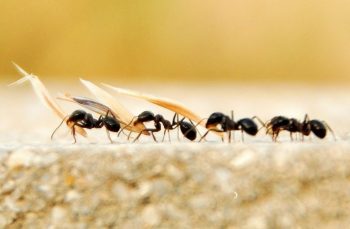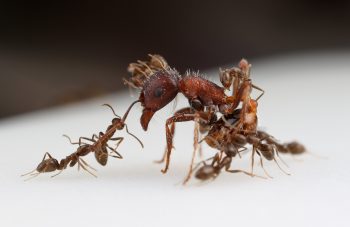February 22nd, 2018
Contributing writer for Wake Up World
Tearing Down the Hive Mind: A History of Walls
The Hopi creation story of this world begins as the last world was ending in an unspecified calamity. A few people — our ancestors — were taken underground, saved by ant people who taught us how to survive, how to grow food and hide from disaster. Eventually people returned above ground and were told to walk walk the four directions of the Earth, and to reunite.
The Great Spirit made an appearance and gathered the peoples of this Earth together, and said to the human beings, “I’m going to send you to four directions, and over time I’m going to change you to four colors, but I’m going to give you some teachings, and you will call these the Original Teachings; when you come back together with each other, you will share these so that you can live and have peace on Earth, and a great civilization will come about.” …
Each of the four races went to their directions and learned their teachings… [but] some of the brothers and sisters had forgotten the sacredness of all things…
— Source: A Cherokee Legend by Lee Brown, Cherokee
[pro_ad_display_adzone id=”110028″]
At first this creation story such seems like many indigenous tales, but comparatively and allegorically speaking the Hopi creation story approaches perfection in its eloquence. Ants are the only animal in the world that humanity can be accurately compared with, so much so that perhaps mankind was influenced by antkind more than any other being. Humans and ants are farmers, warriors, harvesters, thieves and enslavers alike. No other animal behaves like man, except ants, and no other being is as warmongering. Individually we each might be more like a dog or cat, or perhaps we might like to see ourselves as similar in character to a bird, but as a collective, mankind is mostly like antkind.
Human history in total, from whatever nationalistic, religious or otherwise jingoistic perspective one endures, can be read like a proud Argentine Ant’s recital of the invasion of New Orleans, and California. The Argentine Ant spent millions of generations building up not only defensive structures but amassing invasion forces to take over as much of South America as antly possible. Any other ant colony they encounter, they destroy. They vanquish all other antkind and, if ants believe anything at all, they must believe they are the “chosen ants”. Ants are extremely intelligent (if intelligence is measured in utilizing surroundings as tools) and the Argentine Ant grew accustomed to hopping on floating leaves or debris in the Argentine flood plains and hitching rides downstream to effectively expand their territory. They were such mighty warriors with such rich resources that no other ant could challenge them.
When steamships began embarking from Argentinian shores they carried with them invasion force after invasion force of the chosen Argentine Ants. Wherever the ship was steered the ants embarked and began total and complete annihilation not only of all other ants but also of other life that posed competition to their empire. The chosen ants have now formed a global collective. The megacolony of God’s chosen ant superpower has conquered California, Japan and most of the Mediterranean, and they are right now on the march. Interestingly enough, the Argentine Ants recognize and accept each other by affiliation, no matter what continental colony they are from, and destroy all other ants they encounter. They even produce chemicals that recruit their nestmates into battle during these encounters.
Today the Argentine Ant megacolony has traversed the globe, staking claim to significant areas on six continents and eliminating indigenous life in the process. It is a stark parallel to human colonialism, only the insect expansion and elimination is even more one-sided, since no other ant it seems can withstand the forces of the Argentine Ants. On the borders of the new intercontinental megacolonies are ant wars of total annihilation where all fall to the Argentine Ant’s fierceness.
Humankind and antkind: Are we really that different?
“Societies with population explosions, that extend into the millions, are prone to large-scale, intense, tactical warfare. It’s a nature of battle only possible among communities with plenty of excess labor force.” — Mark Moffet
Antkind and humankind alike have virtually no societal limit to their growth. The environment limits their growth, not their instincts or biological needs. Few other species on the planet operate in this manner. The colony might be hundreds, or millions or billions, and growth will continue. No other species have societies of this proportion, and no other animal behaves the way ants and people might. No other species kills and enslaves each other and no other species practices the complete confrontation of war like humans and ants do.
Within each colony, the queen lives for decades and workers live for years under vastly different social and living conditions. The expendable males live for only a matter of weeks. Under the reign of a long history of queens, each colony has a rich history of millions of years and the collective acts with the impetus of such an age old regime. They are biologically reinforced matriarchies with a history so ancient that it must make the rise of humanity seem like just another pulse of different beings to eat off, with different kinds of leaves to ride.
Ants were the world’s first farmers, organizing and harvesting from their surroundings. They effectively raise livestock too and harvest from their surroundings, and such behavior began about 50 million years ago, or more. Today many ants still farm or tend to fungus grown in their lairs for the colony to eat, harvesting plant material for the fungus to consume in turn. Some ants raise aphids for the colony cafeteria. One can almost envision a curious primal human ancestor watching ants do what they do and gaining numerous ideas — good, bad and ugly ideas.
They farm, enslave and steal from other ants, and war on each other over territory. But perhaps the most amazing similarity between antkind and mankind is the fact that we build infrastructure for future use. Mankind and antkind both build structures based largely on concerns of protection from each other; out of concern for war and others stealing from us. Ants build anthills and then build massive tunnels based on defense of the queen if enemy ants were to invade. Mankind builds in the same manner, as a means of protection, galvanizing against the kinds of war and theft we can’t seem to stop ourselves from perpetrating — despite our supposed evolution.
And so our history shares many similarities too. The history of the human collective is like that of a more prideful ant colony, only mammalian with opposable thumbs. We are the aboveground version of ants with internal skeletons instead of external ones, with hands and vocal chords instead of antennae and mandible crushers. And instead of being capable of lifting great weight like ants, we are capable of inventing great machines of war.
Mankind and antkind function, as collectives, in the same way; the only difference is that instead of underground tunnel defenses, man largely built perimeter defenses, though now we have built up walls of every sort and in every place. But we have also built weapons so destructive we could end all of antkind, and mankind, and indeed all life on the planet, superseding our ability to protect ourselves with walls, tunnels or otherwise. Because of man’s inventiveness our “walls” are now largely technological, as is our ability to confront each other.
It is simple to compare ants to humans and actually find reasons for building walls. It is arguable that the predominant measure of distinction between people is differences in perception. It is easy to say that we are as beasts and therefore bound to behave as ants. It is easy to say war is inevitable for both antkind and mankind. It is easy to regress and actually behave like ants — when we think only in a collective state. And yet, we are individuals, we are humans, not ants. We are much more. In fact, our weapons of war demand that we be much more.
So why do we continue to behave as ants?
The antkind and mankind collectives prepare for war instead of peace. And when the opportunity presents itself — because all preparations have been made, or because the opposition is seemingly prepared, or is seemingly not prepared and therefore ought to be confronted — war inevitably takes place. It takes place because it has been readied, through culture and infrastructure. At the borders of ant populations wars are taking place right now where millions are being killed every month. The ants kill each other because of their differences, despite the fact they are all ants. And as history continues to demonstrate, humans, when placed in bordered blocks, suffer the same end; the same wars based on differences, despite our sameness.
The most diverse human borders have always been places of the most hair-raising and antennae flickering wars, like the areas in France and areas where major fighting in WWI and WWII took place. A more intense example of the ant like nature of humanized borders is demonstrated throughout The Middle East. Multiple doctrines, including the “one true religion”, coincide with national differences, heritage distinctions and cultural fluctuations to form borders of all sorts — and war of all sorts.
Humans differentiate each other for a variety of reasons, both entirely absurd and historically valid, but the result is the same — colonies driven by antlike biological impulses (which we call “states with proud histories”) and the outsiders they clash with along their borders.
[pro_ad_display_adzone id=”110030″]
The Complexity of Humanity?
At first glance, humans are not so complicated to understand. We are collectively spurred by the same godly forces that created ants. It is perhaps an impulse from beyond the beyond to not only be tribal and build walls, but to war on each other. It must be an impulse of our biology, for ants do not have complex rational minds as man does. No matter if one is a tiny drone of an underground ant mound or a self-aware human being, the impulse of collectivist societies seems to be to kill beings like us, but not enough like us.
Perhaps the Hopi were more correct than we could ever know. Perhaps long ago man was adopted by ants, or at least adopted the ant ways. We war on each other the same, we enslave each other the same. No other animals are as culturally developed with such refined caste systems, no other species voyages to harvest and conquer, and no other species kills each other on such a massive organized scale. Sure, mankind is more efficient at construction and destruction, we live a little longer, our colonies are more noticeable (and environmentally impactful. Instead of antennae we have phones, and instead of claws and teeth we have knives, guns, and nuclear bombs. But the collectivist mindset of war and colonialism remains the same.
We can conclude by observing antkind that violence and war, however perverse, is rooted in biological aspects. And yet mankind discusses war in terms of tradition, or societal formation, or economics, or politics. People present a range of reasoning for killing each other en masse, justifying war and genocide in the name of religion, and politics, and freedom, and protecting of our way of life. But at its root it’s a biological impulse. And, as evolved beings, it is one we are able to surpass — by thinking as free individuals, not as mindless drones in institutionalized societal collectives. Humans are more complex than the old ant not only because of our complex inventions (most made for and during war) but because of our consciousness — our self awareness — our ability to make choices beyond our biological programming.
So let’s call it what it is. If the politics of war was correctly acknowledged to be the base thinking of less evolved life, like that of anthood, of less conscious beings, people would be far more inclined to surpass the biological response we share with ants by applying alternative higher thinking. As efficient as they are at killing and spreading, ants have barely developed or evolved for the last 150 million years. But unlike antkind, mankind can open our hearts and minds to elevate our thinking and being.
And it’s time we started acting that way.
Bringing Down the Walls
“Oh Great Spirit who made all races, look kindly upon the whole human family and take away the arrogance and hatred which separate us from our brothers.” ~ Cherokee Prayer
The harvesting, farming, raising of livestock, enslavement, and war organization that is common between antkind and mankind make us remarkably similar. But perhaps of all our shared traits, the most detrimental similarity is the fact that antkind and mankind both build walls. Perhaps the fact that we build walls is actually the most markedly similar characteristic between us, preceding all other similarities.
Ants and humans build complex dwellings in part as a way to defend the collective, which appears righteous, but it is primarily the result of the near permanent collective state of war.
Perhaps the fact that we build walls and forts and prepare for war leads to the tendency to war and plunder those outside the walls in the first place. Perhaps the wall builders spurred the necessity to find more efficient means of warring, or plundering resources, or building better forts. Could it be that those physical and societal walls of colonialism cause the war state, rather than wars necessitating a walled state?
Humans have been practicing cultural traditions reminiscent of ants for thousands of years. The reason humans are so good at building is because we are always at war. As a clear example, the histories of war and technological/industrial development have run in total parallel in recent centuries. But humanity has actually been building walls (literally and figuratively) since the time of Han, Nehemiah, and long before.
The Western Wall or Wailing Wall is an ancient wall of high symbolic significance and attachment – people have been killing each other at the base of this wall and all walls for thousands of years. The Wailing Wall is considered sacred. The Great Wall of China is another physical line in the sand where people traditionally killed each other. The Great Wall is so great that it can be seen from space and as a kid, you’re taught that so that you think that walls are great — after all they can be seen from space. (It is significant to note that China did not build the wall initially to keep people out as much as to keep people inside. The most valuable resource of a nation is people, and when there is no wall people tend to leave, which was occurring too much to enable total taxation and control of the Chinese people.)
In reality, walls create confrontation. Walls are perimeters, borders, where war is readied and armament is installed and, where the bordermind kicks in, like that of all great ants. It’s where those who are not enough like us live, on the other side of the wall. But walls also create a contradiction: they make people want to get through them in case there is something worthy behind the wall — something we don’t have but which those who are not enough like us may have.
It is easy to observe ants. We can observe their comings and goings and learn what they do over many lifetimes. So, imagine observing people the same way, from a higher perspective, as we would an ant hill or ant farm. Imagine we could watch the Wailing Wall or the Great Wall of China for a century or two. Imagine if we could watch what happened at the Berlin Wall during its comparatively brief existence. We would see the bordermind of antkind clearly present in mankind too. We would see the erection of those walls cause confrontation.
Walls are an example of false pride. False pride results in the bordermind. An example of false pride is being proud of how you were born; what country you’re from, the quantity of melanin you were born with or without, and the things your ancestors did. Real pride (and even that should be let go or minimalized) is being proud of having done something wonderful on your own. This pride in walls and borders built thousands of years ago is false pride. Forget about the ancient walls and do something new with your own hands. Walls have been getting in the way of the development of our collective mentality for millennia. Walls make us more like ants than farming or harvesting or raising livestock ever could. Walls build up the infrastructure that maintains war, false pride, and the bordermind state of war.
We also build societal and spiritual walls and encase individuals and whole regions in binds. The mental and spiritual binds and encasements we are surrounded by entrap us just as walls do. And just like walls we believe the walls are protecting us when in fact they are perpetuating the mind state of war, our lacking consciousness.
We are educated primarily within walls and informed of the greatness of the Great Wall. We are informed directly and indirectly as we grow up in the education system of the value of walls. We learn from early on about all the great walls and great wars and great buildings people have erected. And while we’re learning the history of mankind we learn to stay in line and shut up. We learn to seal ourselves up behind walls, separate from our community, fearing for our privacy and for the constant threat of theft and intrusion, and we barricade our minds and our spirits closed. We learn to conform by what we are taught and more importantly, how we are taught. We learn that how much we know matters little compared to how much we know about conforming to the status quo. We close ourselves in and make our own individual walls in order to protect us from others, leaving us stuck – with ourselves. The bordermind is initiated and we live encased in spiritual and mental walls we built around ourselves through institutionalization. We are walled in by experiences, by layers of ego armor and a culture of separation in a post-modern society. We close ourselves in from reality in ways we shouldn’t, and try to in ways we couldn’t.
We fortify ourselves, just as ants in a colony, and to wage war, and to give up our individuality to the collective — we even glorify giving up our own lives in war — all in the name of hive-minded colonialism. But to achieve peace, we must evolve beyond it.
We humans have walked the four directions of separateness. Let us return to the circle of oneness, share what we have learned, and create the great human civilization the Hopi prophesied. Let us cease cooperation with systems, institutions and colonialist government which, on thoughtful questioning, prove to be based on the impulses of the lower mind — the hive consciousness. And let us remember and honor the sacredness of all things.
Let down your walls. Open your heart and mind. Think deeply. Consciously develop your individuality. Challenge the status quo, and take action against wrong-doing. And if you found this article valuable, share this point of view with others, so that we may all stop acting as drones to the hive mind and finally bring an end to the colonialism of hollow, war-minded institutions.
The Little Green Book of Revolution
By Ethan Indigo Smith:
 ‘The Little Green Book of Revolution’ is an inspirational book based on ideas of peaceful revolution, historical activism and caring for the Earth like Native Americans.
‘The Little Green Book of Revolution’ is an inspirational book based on ideas of peaceful revolution, historical activism and caring for the Earth like Native Americans.
A pro-individual and anti-institutional look at the history of peaceful proactive revolution, it explores the environmental destruction inherent to our present energy distribution systems and offers ideas to counter the oligarchical institutions of the failing ‘New World Order’.
‘The Little Green Book of Revolution’ is available here on Amazon.
About the author:
Activist, author and Tai Chi teacher Ethan Indigo Smith was born on a farm in Maine and lived in Manhattan for a number of years before migrating west to Mendocino, California. Ethan’s work is both deeply connected and extremely insightful, blending philosophy, politics, activism, spirituality, meditation and a unique sense of humor.
You can connect with Ethan on Facebook, check out his author page on Amazon, or visit his websites, Geometry Of Energy and Meditation 108, where Ethan offers lessons on individuation, meditation, the conceptualization of energy, and the metaphysical significance of 108.
Ethan’s publications include:
- The Complete Patriot’s Guide to Oligarchical Collectivism, an insightful exploration of history, philosophy and contemporary politics.
- The Little Green Book of Revolution an inspirational book based on ideas of peaceful revolution, historical activism and caring for the Earth like Native Americans.
- The Matrix of Four, The Philosophy of the Duality of Polarity on the subject of the development of individual consciousness.
- The controversial book, Terra-ist Letters, a work that humorously contrasts two very serious issues: the prohibition of marijuana and the promotion of nuclear experimentation.
Recommended articles by Ethan Indigo Smith:
- Tibetan Rites of Rejuvenation: a Guide to Meditation and Breath
- Understanding Ascension: The Geometry of Energy
- 11:11 – A Call to the Indigos
- The Seed of Buddha Meditation
- The Mandala: The Sacred Geometry of Meditation
- The Common Origins of Religions and Theology
- Aum Mani Padme Hum: The Integration of Duality and Polarity
- Guardians of the Earth Unite! American Indian Prophecy, The Medicine Wheel, and The Four Sacred Directions
- The Spiritual Golden Rule
- Meditation Comprehension for the Youth
- Meditation 108: A Guide to Meditating for the Infant Practitioner
- Presence and Mindfulness: the Meditative Value of 108
[pro_ad_display_adzone id=”110027″]










